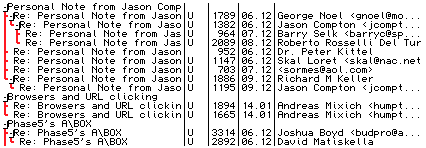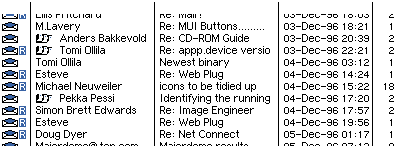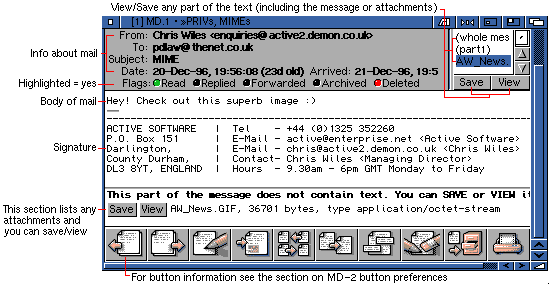
The main GUI is the area where you manage your folders, create news ones, create new messages etc.

The buttons are configurable through the settings GUI
If you have used another email program recently (a program based on the old unix way of handling email messages) you will probably be quite stuck when you first use the Microdot-II interface. This is not a bad thing as in the longer term you'll sick back and realise that Microdot-II makes handling mail and news much easier that many other email programs.

As you will see from the image Microdot-II works by building threads. These are messages which relate to each other. If, for example, you created an email and sent this to a friend (with the subject:Voyager is great") your friend will most likely respond (and the subject heading would like like re:Voyager is great) with the same subject header. If you then replied to his reply and he, in turn, replied again, you would start to build a thread of mails which looked something like:

So what's so special about threads? Well, if you have 100's of mails in your mailbox (which can happen after a few months being connected to the Internet) it is very difficult to look back and follow "conversations" which have occured a few months ago. Say, for example, your friend had put a phone number within one of the "Voyager is great" messages and a few months later you remembered that the phone number was in one of these mails. With Midrodot-II you could look back through the mails and instantly find the "Voyager is great" threads (ie. collection of mails relating to one subject).
With a normal mailer (which does not work with threads) you would have to search through your mails one by one looking for the "Voyager is great" subject header which, in between 100 mails, may not be too easy to find!
Here are two images showing the difference between a threaded mailer and a mailer which works with the old unix-style line-by-line system:
| Threads Example | Normal List Based |
|---|---|
 |  |
As you will see, the threaded approach is more more clear and easier to follow. In use, the
threaded system is a god-send when you are working with many messages.
If you double-click or press return on any message within the Message List GUI you will be able to read the contents of that message.

This GUI is split into various areas. At the top you have the section which gives you the essential information about the message - Who is it from, the subject, time it was written etc. Underneath this you have a set of "bulbs" which, if lit, inform you of an action. For example, if the bulb for read was lit it would tell you that you have already read this mail. If delete was lit then this mail would be marked ready for deletion.
Underneath the "bulbs" you have the area which contains the message. If the message is a MIME based you might have the option to SAVE or VIEW any attached files. If you look to the top right of this GUI the same options are available. You will see a attached files lister where you will be able to save or view attached files.

When you want to create a new message this is the GUI where you would type your text. More information about creating a message can be found here.
First col: U = unread (seen, but not read)
N = new, not yet seen
= read
Second col: D = deleted
A = archived (will not expire)
= normal
(Note that A takes precedence over D)
Third col:
Non-Spool: R = Replied to
F = Forwarded
B = Replied to and forwarded
Spool: M = already mailed out
P = already posted
S = already send and posted
(aka completely send)
Go to the previous, next, chapter, table of contents.